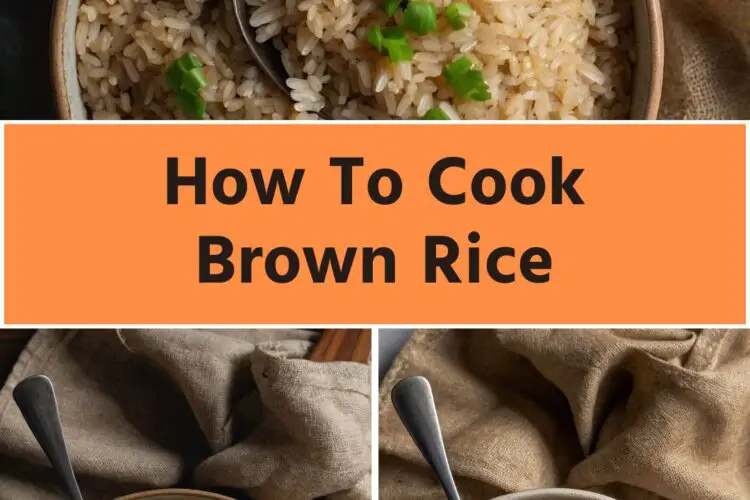Before diving into the delightful world of brown rice, let’s talk about what makes it shine on your dinner plate. Imagine a colorful stir-fry of vibrant vegetables and succulent chicken or tofu drizzled with a homemade ginger soy sauce. Picture a comforting curry where spicy chickpeas or tender sweet potatoes dance together with brown rice, soaking up all those rich flavors.
Then there’s the classic combination of brown rice and beans, where you can really appreciate the wholesome nuttiness while getting a healthy dose of protein and fiber. Whether you’re having it with grilled fish, a zesty salad, or even a luscious vegetable soup, brown rice is incredibly versatile and pairs beautifully with numerous dishes.
Now, let’s embark on our journey in mastering how to cook brown rice, bringing taste, health, and satisfaction into our homes.
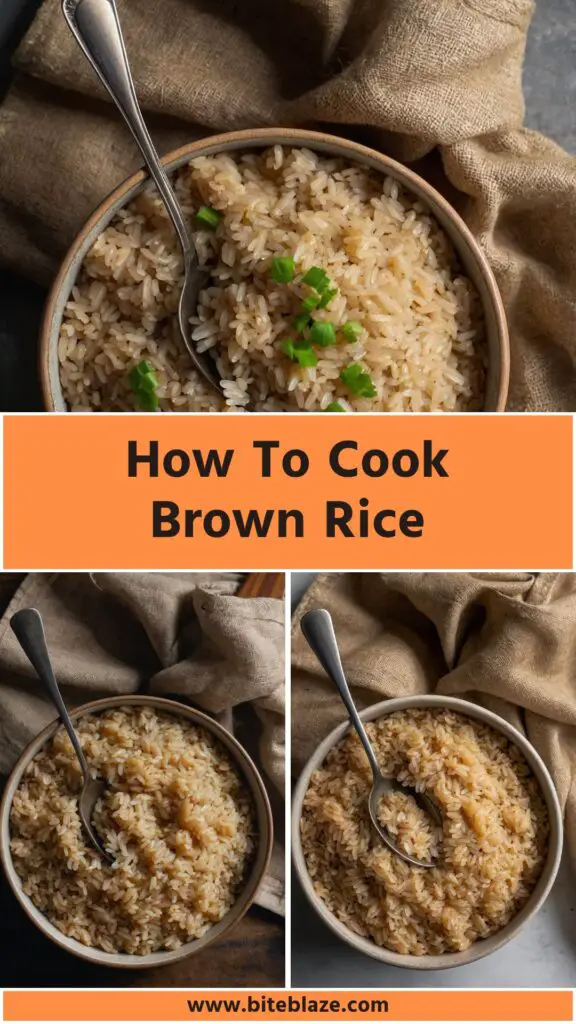
I remember the first time I attempted to cook brown rice. Picture this: half an hour of simmering, followed by hours of my family asking if dinner was ready. What was supposed to be a simple side dish turned into a culinary lesson on patience. But through experimentation and learning from my kitchen misadventures, I discovered the right methods to make this wholesome grain effortlessly perfect.
Brown rice is more than just a side dish; it’s a staple with numerous health benefits. It’s packed with nutrients, fiber, and has a lower glycemic index compared to white rice. For those who think cooking it is challenging, let me assure you—it’s simpler than you might think. Let’s dive into what makes brown rice special, how to make it, and elevate your meals to new heights.
What is Brown Rice?
Brown rice is a whole grain that retains its bran and germ, unlike white rice, which has had these nutritious parts removed. This means it’s rich in antioxidants, vitamins, and minerals. The nutty flavor of brown rice, coupled with its chewy texture, opens up a world of culinary possibilities. When done right, it can be the star of the show or a delightful backdrop for other amazing flavors.
What Makes This Recipe Different from Other Brown Rice Recipes?
For many, cooking brown rice can be daunting. I’ve encountered various methods online, but they often lack clear guidance and attention to detail. My technique emphasizes simplicity and achieving that desired fluffy texture without compromising flavor. This recipe incorporates a few secret ingredients to elevate the taste, making a significant difference in the final dish.
You will also like the following Side dishes recipes!
How Does It Taste?
Imagine the warm earthiness of brown rice combined with a subtle nuttiness. This grain has a heartier flavor profile compared to its white counterpart. It’s not just food; it’s an experience, a cuddle for your taste buds. When you cook it with a hint of olive oil and salt, that comforting aroma fills the kitchen, beckoning everyone to gather around the table.
Ingredients You’ll Need to Make Brown Rice
To get started on this wholesome journey, gather the following ingredients:
1 cup whole-grain brown rice, thoroughly rinsed: Ensures you wash away excess starch, aiding in better texture.
2 cups filtered water: A crucial component for cooking brown rice to perfect tenderness.
½ teaspoon sea salt: Enhances flavor and brings out the rice’s inherent nuttiness.
1 small garlic clove, lightly crushed: Infuses subtle flavor during cooking—goodbye bland rice!
1 teaspoon cold-pressed extra-virgin olive oil: Adds richness and depth, making every bite enjoyable.
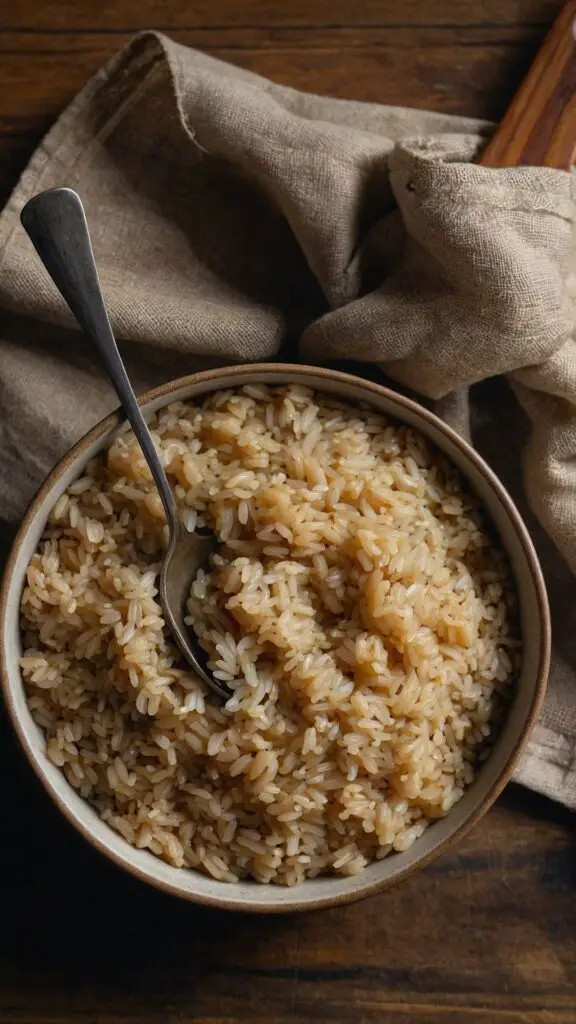
Step-by-Step Instructions
Now let’s get into the nitty-gritty of cooking brown rice.
Step 1: Rinse the Rice
Begin by rinsing the brown rice under cold water. This step removes excess starch, preventing your final dish from becoming gummy. Place the rice in a fine-mesh sieve and rinse it under cool running water until the water runs clear. This may take a minute or so. Trust me, it’s worth the time.
Step 2: Add Ingredients to the Pot
In a medium-sized pot, combine the rinsed brown rice, 2 cups of filtered water, the sea salt, and garlic. Stir to combine. If you want to kick it up a notch, you can toss in a few herbs or spices like bay leaf or cumin at this point.
Step 3: Bring to a Boil
Place the pot over medium-high heat and bring everything to a boil. You want to see those bubbles popping! Once you reach a vigorous boil, it’s time for the next step.
Step 4: Reduce the Heat and Cover
When it boils, lower the heat to a gentle simmer. Cover the pot tightly with a lid—this helps to keep the steam in, which is essential for cooking the rice evenly.
Step 5: Cook the Rice
Allow the rice to simmer for 45 minutes. Yes, it takes time, but good things come to those who wait! Avoid the temptation to peek. Each time you lift the lid, you let steam escape, and that’s not good for the cooking process.
Step 6: Rest the Rice
Once 45 minutes have passed, turn off the heat and let the rice sit for 10 minutes. This allows the remaining steam to work its magic, fluffing up the rice perfectly.
Step 7: Fluff and Serve
After resting, take a fork and gently fluff the rice, breaking up any clumps. Drizzle the extra-virgin olive oil over the top and mix. Now, it’s ready to serve alongside your favorite dishes.
Tips & Tricks on Making Brown Rice
Here are some tips I’ve learned through trial and error:
Use Good Quality Water: Relying on filtered water improves the flavor and overall quality of the dish.
Don’t Skip Rinsing: This short step maximizes flavor and improves the texture.
Experiment with Broths: For more flavor, try cooking your rice in vegetable or chicken broth instead of water.
Timing is Everything: Follow the timing closely. No peeking!
Make It Ahead: Brown rice stores well. Cook a batch and refrigerate for easy meals throughout the week.
Nutrition Information
Brown rice is a nutritional powerhouse. Here’s a breakdown per cooked cup:
This makes it an excellent choice for maintaining energy, aiding digestion, and improving overall health.
How Do I Store This Dish?
When it comes to storing brown rice, it’s straightforward:
- Cool Completely: Let leftover rice cool to room temperature.
- Store in an Airtight Container: Transfer to an airtight container and refrigerate for up to 5 days.
- Reheating: Heat it in the microwave, adding a splash of water to keep it moist.
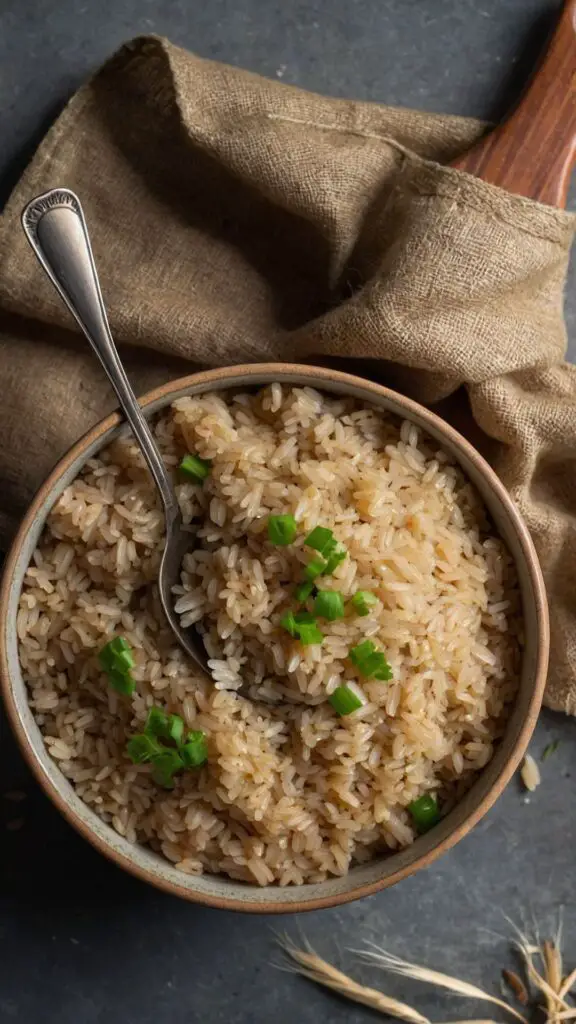
What Other Substitutes Can You Use in Brown Rice?
If you’re looking for alternatives or enhancements, consider the following options:
Quinoa: A protein-packed substitute with a unique texture and nutty flavor. It’s gluten-free and cooks faster.
Farro: This ancient grain offers a chewy texture similar to brown rice but with a slightly nuttier flavor.
Barley: Adds a distinctive earthiness; great for soups or salads.
Wild Rice: Technically a grass, wild rice adds a dark color and earthy flavor.
Cauliflower Rice: For a low-carb or gluten-free option, cauliflower rice gives a similar texture with fewer calories.
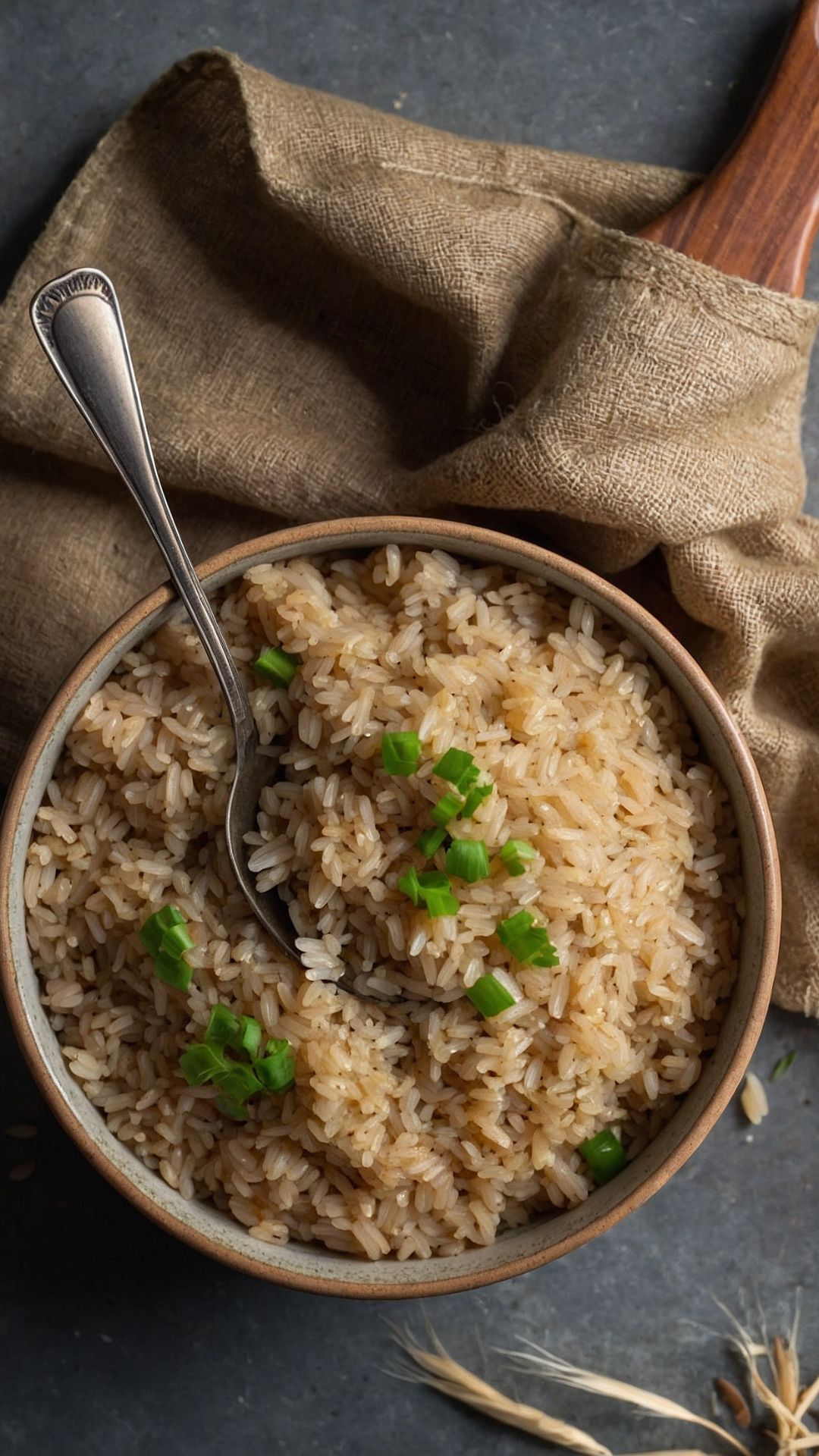
How to Cook Brown Rice
Ingredients
Equipment
Method
- Begin by rinsing the brown rice under cold water. This step removes excess starch, preventing your final dish from becoming gummy. Place the rice in a fine-mesh sieve and rinse it under cool running water until the water runs clear. This may take a minute or so. Trust me, it’s worth the time.
- In a medium-sized pot, combine the rinsed brown rice, 2 cups of filtered water, the sea salt, and garlic. Stir to combine. If you want to kick it up a notch, you can toss in a few herbs or spices like bay leaf or cumin at this point.
- Place the pot over medium-high heat and bring everything to a boil. You want to see those bubbles popping! Once you reach a vigorous boil, it’s time for the next step.
- When it boils, lower the heat to a gentle simmer. Cover the pot tightly with a lid—this helps to keep the steam in, which is essential for cooking the rice evenly.
- Allow the rice to simmer for 45 minutes. Yes, it takes time, but good things come to those who wait! Avoid the temptation to peek. Each time you lift the lid, you let steam escape, and that’s not good for the cooking process.
- Once 45 minutes have passed, turn off the heat and let the rice sit for 10 minutes. This allows the remaining steam to work its magic, fluffing up the rice perfectly.
- After resting, take a fork and gently fluff the rice, breaking up any clumps. Drizzle the extra-virgin olive oil over the top and mix. Now, it’s ready to serve alongside your favorite dishes.
Nutrition
Notes
- Use Good Quality Water: Relying on filtered water improves the flavor and overall quality of the dish.
- Don’t Skip Rinsing: This short step maximizes flavor and improves the texture.
- Experiment with Broths: For more flavor, try cooking your rice in vegetable or chicken broth instead of water.
- Timing is Everything: Follow the timing closely. No peeking!
- Make It Ahead: Brown rice stores well. Cook a batch and refrigerate for easy meals throughout the week.
Tried this recipe?
Let us know how it was!Frequently Asked Questions
1. How long does it take to cook brown rice?
Typically, it takes about 45 minutes for brown rice to cook thoroughly. Allow for additional resting time, so plan for about an hour from start to finish.
2. Is brown rice healthier than white rice?
Absolutely! Brown rice retains the bran and germ, providing more fiber, vitamins, and minerals, which offer several health benefits.
3. Can I freeze cooked brown rice?
Yes! Cooked brown rice freezes well. Let it cool completely, then transfer it to a freezer-safe container. It will last for several months.
4. What if my brown rice is still hard after cooking?
If the rice is hard, it likely needs more moisture. Add a bit of water, cover, and cook for an additional 10-15 minutes.
5. Can I add vegetables directly to the cooking rice?
Yes, you can! Try adding diced vegetables like carrots or peas for extra flavor and nutrition. Just be aware that they can alter the cooking time slightly.
Conclusion
Cooking brown rice doesn’t have to be an overwhelming task. With a few key insights and a simple method, you can master it in no time. Its versatility and health benefits make it an essential component of your kitchen. Pair it with vibrant veggies, hearty proteins, or flavorful sauces, and watch it transform any dish into something special.
Brown rice isn’t just food; it’s a canvas for flavors and textures. So, the next time you sit down to a meal made with brown rice, relish the flavors, and appreciate the effort you put in. Happy cooking!

